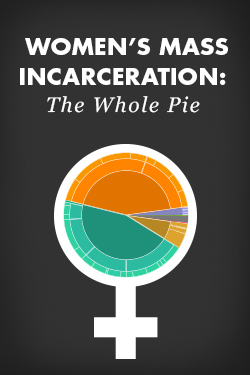Women’s mass incarceration gets Whole Pie analysis
New report details the number of women who are locked up by various correctional systems and why.
October 19, 2017
 With 219,000 women locked up in facilities operated by thousands of agencies, getting the big picture is anything but easy. In our new report, Women’s Mass Incarceration: The Whole Pie 2017, we use our “whole pie” approach to give the public and policymakers the foundation to end mass incarceration without leaving women behind.
With 219,000 women locked up in facilities operated by thousands of agencies, getting the big picture is anything but easy. In our new report, Women’s Mass Incarceration: The Whole Pie 2017, we use our “whole pie” approach to give the public and policymakers the foundation to end mass incarceration without leaving women behind.
Our new report details, for the first time, the number of women who are locked up by various correctional systems and why. Women’s Mass Incarceration: The Whole Pie 2017, released jointly by the Prison Policy Initiative and the ACLUs Campaign for Smart Justice, is a first look at where women fall within our decentralized and overlapping systems of mass incarceration.
For example, we find that a quarter of incarcerated women are unconvicted, highlighting serious questions about how we use incarceration in the United States. And the report finds that “[i]n stark contrast to the total incarcerated population, where the state prison systems hold twice as many people as are held in jails, incarcerated women are nearly evenly split between state prisons and local jails.” These findings reinforce the importance of considering jails, not just prisons, in ending mass incarceration.
The report provides a breakdown of offense types for women incarcerated in local, state, and federal correctional systems. And while the distribution of offenses is different for women than for the general incarcerated population, our analysis confirms that meaningful reform and ending mass incarceration requires looking beyond non-violent drug and property offenses.
Incarcerated women have long been overlooked in criminal justice statistics. Women’s Mass Incarceration: The Whole Pie 2017 starts to fills that void.



